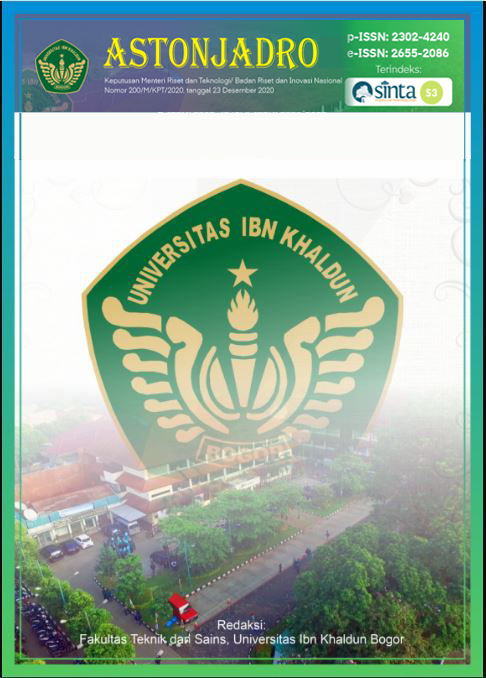Analysis of the Impact of Electric Vehicle Technology on Reducing Greenhouse Gas Emissions
DOI:
https://doi.org/10.32832/astonjadro.v13i3.15533Keywords:
greenhouse gasses; electric vehicles; motorized; human helath.Abstract
One of the causes of increasing temperatures throughout the earth is the environmental impact resulting from exhaust from vehicles. This exploration is expected to determine the impact of the seeding system caused by mechanical vehicles. This exploration was carried out using written survey research techniques as clarification that could increase public information regarding the impact system of motor vehicle seeding. The seeding impact is the retention and removal of radiant energy from electromagnetic waves by gasses in the climate. The impact of seeding can prevent energy from sunlight from being reflected outside the earth. The impact of seeding can occur due to exhaust gasses, one of which is produced by motorized vehicles. Increased use of motorized vehicles can cause a rapid increase in smoke emissions. Because every motorized vehicle will emit smoke or ignition gas from the motorbike's combustion chamber. Vehicle engine exhaust emissions do not depend on how new or how old the vehicle is, but very much depend on the quality and maintenance of the vehicle engine. The rapid number of motorized vehicles is a consequence of the needs and demands of human existence. The outflow of motorized vehicles is also a major source of environmental pollution because they contain air pollution which is not good for human health.
References
Parinduri, L., Yusmartato, Y., dan Parinduri, T. (2018). Komitmen untuk Mengubah Kendaraan Biasa menjadi Kendaraan Listrik dalam Melawan Kerusakan Atmosfer yang Berbahaya. Terbang (Diary of Electrical Innovation), 3(2), 116-120.
Boedoyo, MS (2008). Pemanfaatan inovasi untuk mengurangi pembuangan zat perusak ozon. Buku Harian Inovasi Alam, 9(1).
Ismail, A. (2020). Potensi Penurunan Aliran Keluar Bahan Perusak Ozon (GRK) dalam Latihan Pembelajaran di Rumah Secara On-Line: Investigasi Kesan Karbon. Jukung (Buku Harian Perancangan Alam), 6(2).
Rawung, FC (2015). Kecukupan ruang terbuka hijau (RTH) dalam mengurangi keluarnya bahan perusak ozon (GRK) di wilayah metropolitan Boroko. Matrasain Media, 12(2), 17-32.
Pramudiyanto, A.S., dan Suedy, S.W.A. (2020). Bersih dan Tidak Berbahaya bagi ekosistem Energi dari Biomassa untuk Mengurangi Dampak Zat Perusak Ozon dan Perubahan Lingkungan yang Berlebihan. Buku Harian Kekuatan Baru dan Berkelanjutan, 1(3), 88-89.
Pramudiyanto, A.S., dan Suedy, S.W.A. (2020). Bersih dan Tidak Berbahaya bagi ekosistem Energi dari Biomassa untuk Mengurangi Dampak Zat Perusak Ozon dan Perubahan Lingkungan yang Berlebihan. Buku Harian Kekuatan Baru dan Berkelanjutan, 1(3), 86-99.
Sudjoko, C (2021). Strategi Pemanfaatan Kendaraan Listrik Berkelanjutan Sebagai Solusi Untuk Mengurangi nEmisi Karbon, 2(2).
Fitriana, I., Sugiyono, A., Adiarso., Akhmad K. (2020). Pengembangan Kendaraan Listrik Baterai di Indonesia: Peran Dalam Mengurangi Emisi.
Boedoyo, MS ( 2008). Penerapan Teknologi untuk mengurangi gas rumah kaca.
Shenga M, Sreenivasan AV, Tajm K, Do B. (2021). Analisis menyeluruh mengenai emisi gas rumah kaca dan konsumsi energi untuk kendaraan listrik: studi perbandingan di oseania.
Komnos D, Tsiamakis S, Pavlovic J, Ntziachristos L, Fontaras G. (2022). Menganalisis konsumsi bahan bakar dan energi dunia nyata pada mobil konvensional dan listrik di eropa.
Qiao Q, Zhao F, Liu Z, Dia X, Hao H. (2019). Emisi gas rumah kaca siklus hidup kendaraan listrik di tiongkok : menggabungkan siklus kendaraan dan siklus bahan bakar.
Gray N, O’shea R, Wall D, Smith B, Pinet LNL, Murphy JD. (2022). Baterai, sel bahan bakar, atau mesin ? penilaian prbabilistik ekonimo dan lingkungan terhadap listrik dan bahan bakar listrik untuk kendaraan barang berat.
Wang L, chen X, Zhang Y, Li M, Li P, Jiang L, Sia Y, Li Z, Hou T. (2021). Peralihan ke kendaraan listik dapat menghasilkan pengurangan PM 2.5 dan NO2 yang signifikan di seluruh Tiongkok.
Zainuri F, Danardono AS, Adhitya M, Prasetya S, Widiyatmoko, Syuriadi A. (2020). Analisis kinerja konversi kendaraan konvensional ke listrik.
Downloads
Published
How to Cite
Issue
Section
License
Copyright (c) 2024 ASTONJADRO

This work is licensed under a Creative Commons Attribution-ShareAlike 4.0 International License.
Paper submitted to ASTONJADRO is the sole property of the Astonjadro Journal. Unless the author withdraws the paper because he does not want to be published in this journal. The publication rights are in the journal Astonjadro.ASTONJADRO
LICENSE
This work is licensed under a Creative Commons Attribution-ShareAlike 4.0 International License.
Based on a work at http://ejournal.uika-bogor.ac.id/index.php/ASTONJADRO













